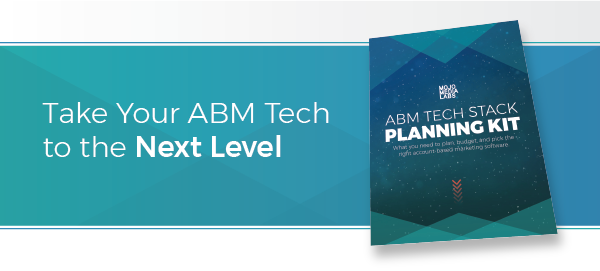How to Measure your Success with Account-Based Marketing
You're looking to build an account-based marketing (ABM) program and launch your first campaign. How do you know what's working? How do you measure the metrics that matter?
With an ABM strategy focused on acquiring target accounts, it can be difficult to know what metrics to measure.
This blog will walk you through how to determine what metrics are most important for your ABM campaign and your business's growth.
Also, here's a practical video walking through these concepts with an example company.
Start with the End in Mind
The clearest way you can tell if you are successful with your account-based marketing efforts is by measuring your current and projected revenue against your revenue goals.
The ultimate goal of effective ABM is to create long-term increased revenue by matching your company to your best-fit customers. By starting with a five-year revenue goal, you can start working backward to understand the steps you need to take to get there.
This exercise proves helpful for three reasons.
- Some companies haven't created tangible and clear goals for their business. If you aim at nothing, you will hit it every time. By coming together to create agreed-upon goals, you can foster internal alignment. Then Everyone starts to assess if what they do will help to attain the goals presented.
- You can set accurate expectations and goals for continued year-over-year growth before you dedicate plenty of time and money into something that could potentially not produce as expected.
- When you set clear revenue goals, all other metrics will naturally fall into place. If you need to onboard 20 new customers to hit your revenue goal, you need to have a lot more than 15 clients in the pipeline.
With all of this said, you need to write this revenue goal down in pencil until you have worked through the next section.
What is your Average Deal Size and Customer Lifetime Value?
With a revenue goal written in pencil, you now need to assess a reasonable expectation for year-over-year growth. The best way to assess your potential year-over-year growth is to look at your average deal size, customer lifetime value, and the average number of new customers.
To determine your average deal size, work with your finance department or sales team. You will want to eliminate any potential outliers that could dramatically skew your results. You are trying to assess what your standard client will bring in with the closing of any deal.
Once you have determined your average deal size, you want to assess a customer's lifetime value. Once you have assessed the average deal size, you will want to look at how long your average customer continues a partnership with your business.
Again, you will want to eliminate any potential outliers that could dramatically skew your results.
With your average customer lifespan and average deal size, multiply those two averages together to get your average lifetime value.
With your average deal size and the lifetime value of your customers, the last piece you want to consider is the number of customers your can onboard in a given year. Many B2B companies have a complex product that results in a longer onboarding process. If you have a longer and more complex onboarding process, this could become a bottleneck for closing new deals.
With these three pieces in place, you can start to assess if your revenue goals are reasonable.
Create a Net New Account Goal
Now that you have created and confirmed your revenue goals, you need to start assessing how many target accounts you need to onboard each year to reach your goals. Based on your average deal size, determine how many new accounts you will need to close each year to reach your long-term revenue goals.
As you match better fit customers to your company, you will start to see the deal size and lifetime value increase. For your planning with this initial campaign, you will want to keep your expectations based on the historical data you have seen. Everyone will be happier if you set the revenue expectations on your historical data and you end up exceeding the expectations.

Measure Account Engagement
With a set expectation of the number of net new accounts for the year, you need to measure the engagement of your target accounts on an account level.
Start by mapping out your entire buyer's journey. Start with how they first hear about you, and outline each step of how they move forward until they have become a new account for your business.
Once you have outlined the entire buyer's journey, start with the number of net new accounts you need in a given year, then move backward through each step of your sales and marketing process, starting with sales.
Measuring Sales Success
Of all of the metrics to measure, your sales metric will provide the most crucial. When you align your marketing and sales teams, the goal was to help ensure more conversations between decision-makers and sales.
For most B2B companies, there is a longer, more complex sales cycle requiring numerous conversations before an agreement ever reaches the customer. You need to start with your last sales conversation in mind and work backward from there.
For example, you may have three or four conversations before you have sent over an agreement for signature.
You have potential customers disengage from your sales process at a different point in each stage of the buyer's journey. If you have the marketing data to assess the number of customers that drop off at each stage, use the data you have today.
If you don't have that data, either underestimate your percentage based on the conversation you have with your sales reps or assume you only close between 5% and 10% of any potential customer that initiates the sales process.
ABM has been shown to improve close rates over time. As you're starting, it's better to underpromise and overdeliver than the other way around.
Since you know the number of net new accounts you need to onboard in a given year, you may consider breaking that down into the number of accounts you need to onboard monthly or quarterly. Take that monthly number and work backward to determine the number of sales conversations you need to achieve the required monthly deals.
Measuring Pre-Pipeline Success
For many people, they consider the pre-pipeline something as exclusively a marketing measurement. With ABM, marketing and sales work together to achieve the success needed to close target accounts. Though the sales process may have a clear-cut stage for measuring success, the pre-pipeline has some blurred lines.
To start to understand measurement, begin by assessing your marketing. You need to look at the number of accounts engaging with your marketing. There are three high-level stages to assess as you look at your marketing: conversions, engagement, and attraction.
Like the sales conversation stages, you will have numerous accounts in each of the stages outlined, but not every target account moves from one stage to the next.
The conversion stage is typically the most easily understood. This stage is where you assess the number of target accounts that have initiated a sales conversation. This conversion could include a form submission, a live chat with sales, or clicking a link to call.
These conversions often move directly into the first stage of the sales process, so once you understand the number of initial sales calls you need, you know how many marketing conversions you need. You can look at the number of accounts you have actively engaged with your marketing that move forward with a sales conversion to determine your conversion rate.
The next stage of the pre-pipeline process is the engagement stage. In traditional digital marketing, the engagement stage would include measuring anything related to average time on site, average pages per session, and product page views.
These metrics still are valuable when looking at specifically your target accounts. One of the key differences between an inbound marketing strategy and an ABM strategy is that your sales team may directly engage with target accounts showing high engagement with your marketing.
When you have target accounts that show a spike in engagement, that's a sign to your sales team to start reaching out to start the sales process. As a result, salespeople may end up having a cold call that qualifies as a connection call.
The engagement stage will still have many target accounts that don't start the sale process immediately, but if marketing and sales are aligned well around the success of a target account, the engagement stage can start directly resulting in many more sales conversations and deals.
The last stage of the pre-pipeline process is the attraction stage. In this stage, the metrics to measure are target accounts on your website, bounce rates, channels generating traffic, and buyer intent.
Of all of these metrics, the buyer intent should take the majority of your focus. If a target account starts to show signs of buyer intent, your marketing team should start to send targeted ads to bring them to your website so they can start engaging with your company and sales team.
Learning to Optimize
As you look at all of the metrics you are running your marketing reports on, identify where the vast majority of your target accounts are dropping off. Focus more of your efforts on improving that portion of your marketing and sales process.
The most important thing you can do is start implementing reporting tools to measure your marketing metrics. If you don't measure something, you likely aren't going to know you need to improve it.
Get Started Today
As you have read over this and watch the video, you may not have the appropriate technology in place to start collecting this data and generate any kind of monthly marketing reports. If you don't have the appropriate tools in place, you won't have the ability to measure your success. Start by looking at your technology. In the meantime, research industry averages to know what your metric benchmarks should be.
Please use the guide below to start auditing your technology. This workbook will walk you through how to audit your existing technology and give a few recommendations on the technology you could implement today.
An effective ABM program requires a great deal of investment, but it will generate a high return on investment when implemented properly. If you'd like help ensuring you receive the ROI you're looking for, schedule a call today to speak with a growth consultant.



